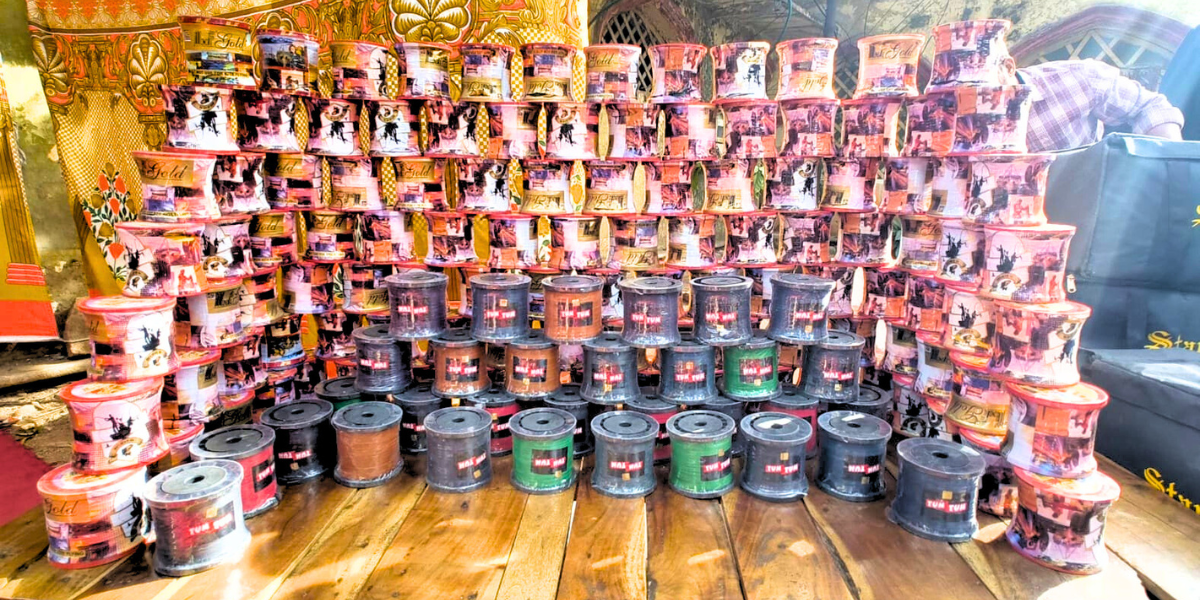Despite a ban on the dangerous Chinese 'manja' people still use them to cut the threads of other kites midair.
Published Jan 14, 2025 | 9:16 PM ⚊ Updated Jan 14, 2025 | 9:16 PM

Hyderabad is bearing witness to a 'Chinese' Manja crackdown
Kites of various hues fluttering in the sky paint a pretty picture though the strings that keep them flying and under control come with danger attached.
The kites that dot the skies of Telangana and Andhra Pradesh add to the Sankranti festive spirit. However, those flying the kites, in their competitive excitement, put the lives of humans, birds, and animals in danger by using the Chinese manja.
Though called Chinese manja, the synthetic treads coated with minute glass shards and sharp metallic powder — which helps the kite flyer to cut the threat of other kites midair — have no China connection. They are locally procured and sold, despite a ban on them.
In the lead-up to Sankranthi, the Cyberabad police released an advisory regarding the “Hazards of Nylon Chinese manja and Glass- or Metal-Coated Desi Kite Strings.”
Urging the public to avoid using such strings, the police noted that “these materials pose severe risks to human life, animals, and the environment.”
The nylon manja is highly sharp and abrasive. They could cause deep cuts and serious injuries. The police also noted that motorcyclists, cyclists, and pedestrians are particularly vulnerable to these hazardous threads. The discarded threads, too, pose a danger. Additionally, they are non-biodegradable, causing water and soil pollution.
On 12 January, the Telangana High Court directed the state to impose a total ban on the Chinese manja. Justice B Vijaysen Reddy directed the Director General of Police (DGP) and other officers to implement the ban strictly.
Earlier, the National Green Tribunal (NGT) had banned the use of Chinese manja in 2017. Furthermore, its use is also a cognizable offence under the Bharatiya Nyaya Sanhita (BNS) wherein under Section 233 it is punishable by a fine of ₹5,000 or imprisonment of a year.
Despite the ban, Chinese manja is still available in the markets. For example, on 13 January, the Hyderabad City Police Task Force said it seized Chinese manja worth nearly ₹88 lakh since October 2023.
Similarly, the police apprehended 148 individuals for selling Chinese manja. Additionally, they also filed 107 cases. The Hyderabad City police have seized 7,334 manja bobbins.
Hyderabad City Police Additional Deputy Commissioner Srinivas Ande is the head of the task force.
“Following Commissioner C V Anands’s directions, we’ve started a proper drive in December 2024,” he told South First. “We’ve been acting as per the NGT’s 2017 ban on Chinese manja. The cases are booked under the Environmental Protection Act,” he added.
“See, Chinese Manja is easily distinguishable from the traditionally used cotton threads,” he explained. “You can often spot it merely by looking at it. It looks synthetic and has some lustre.”
The officer said the Chinese manja is not produced in Telangana. “The manja that we’ve seized until now came from states like Delhi and Gujarat and cities like Mumbai,” he said. “As far as I know, there haven’t been any serious cases of injuries due to Chinese manja this season.”
“Thanks to the efforts of the task force, we’ve almost completely eliminated Chinese manja from Hyderabad,” he claimed.
However, a majority of the arrests made in Hyderabad are that of the vendors. The police have yet to book any suppliers.
(Edited by Majnu Babu).
